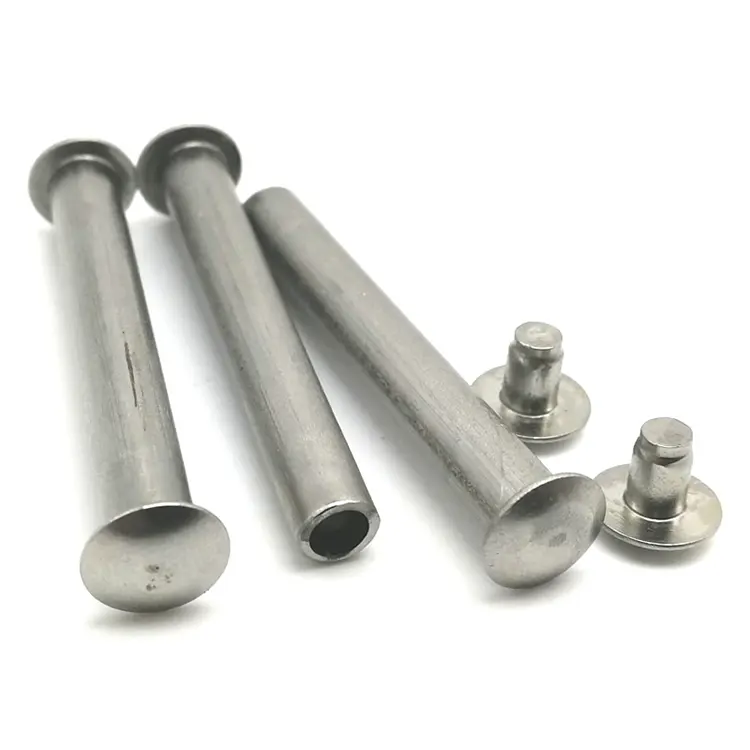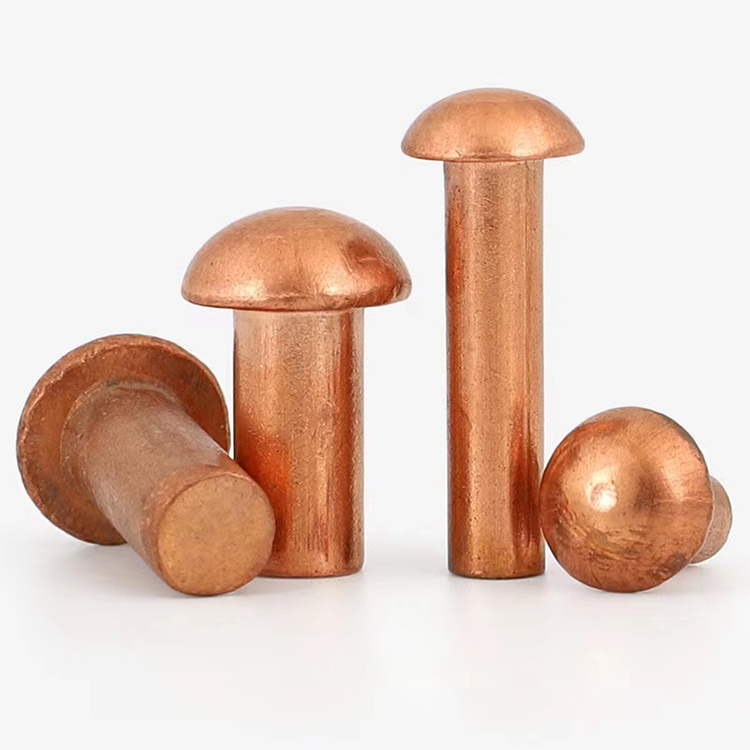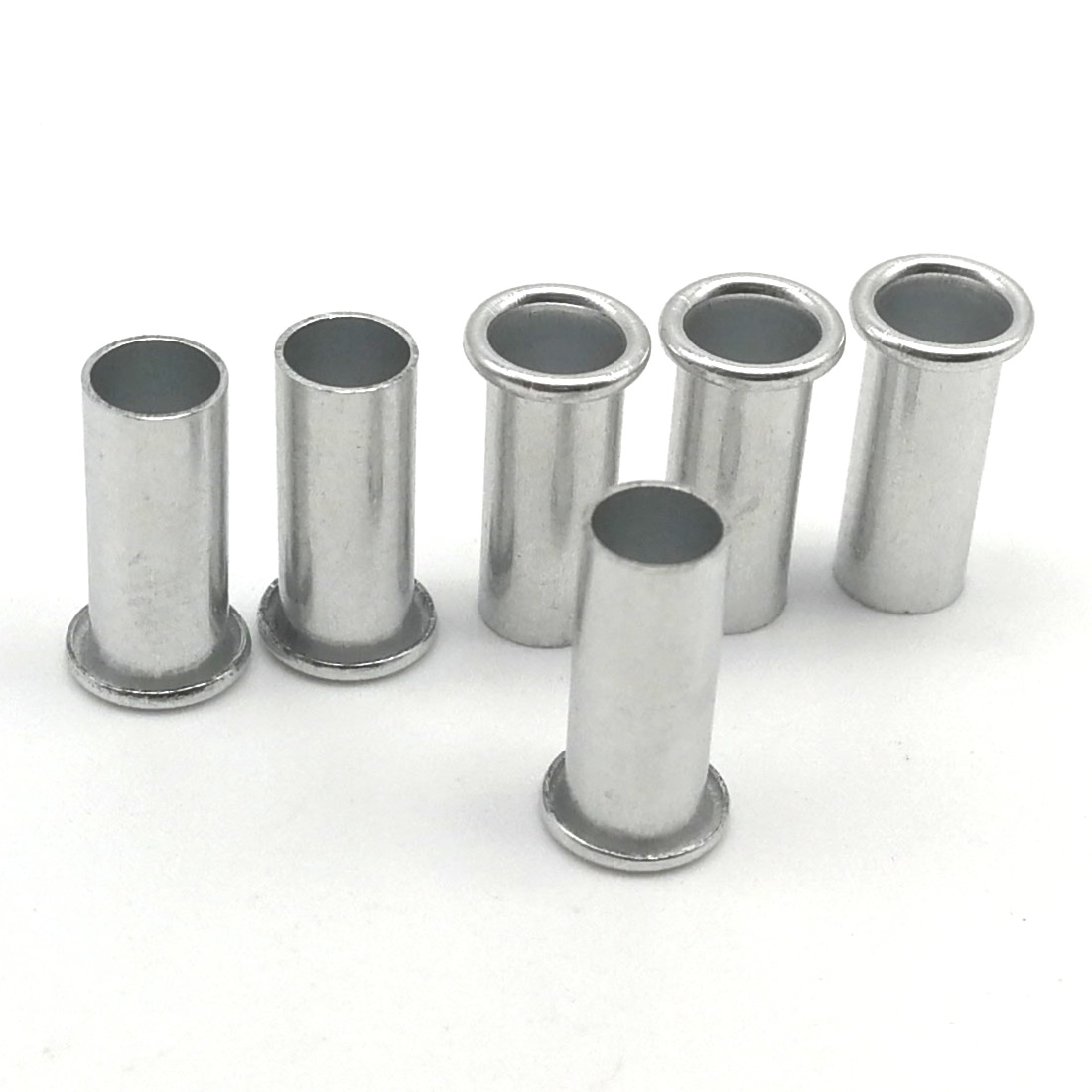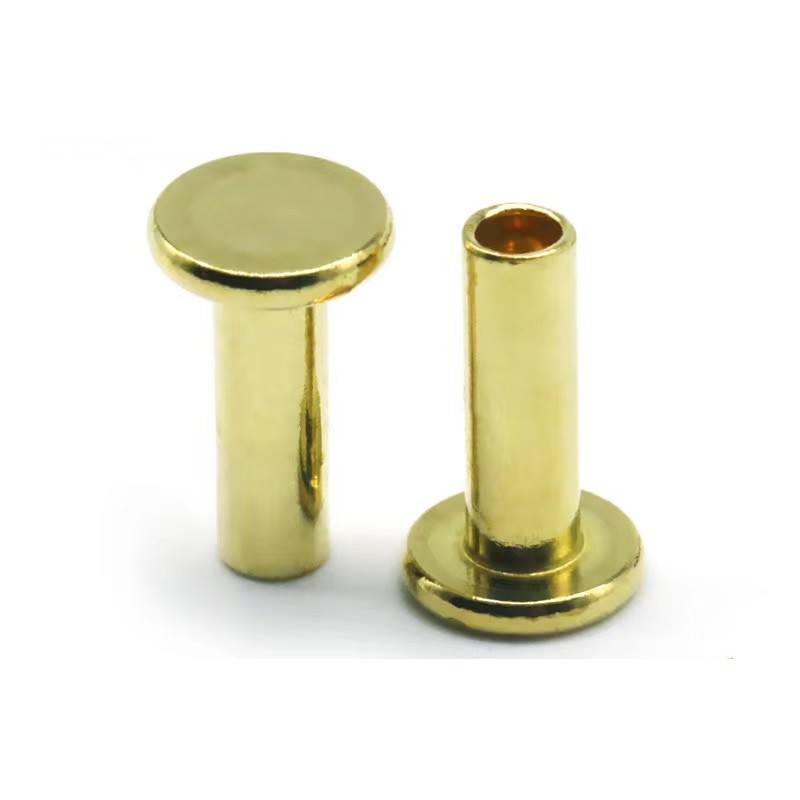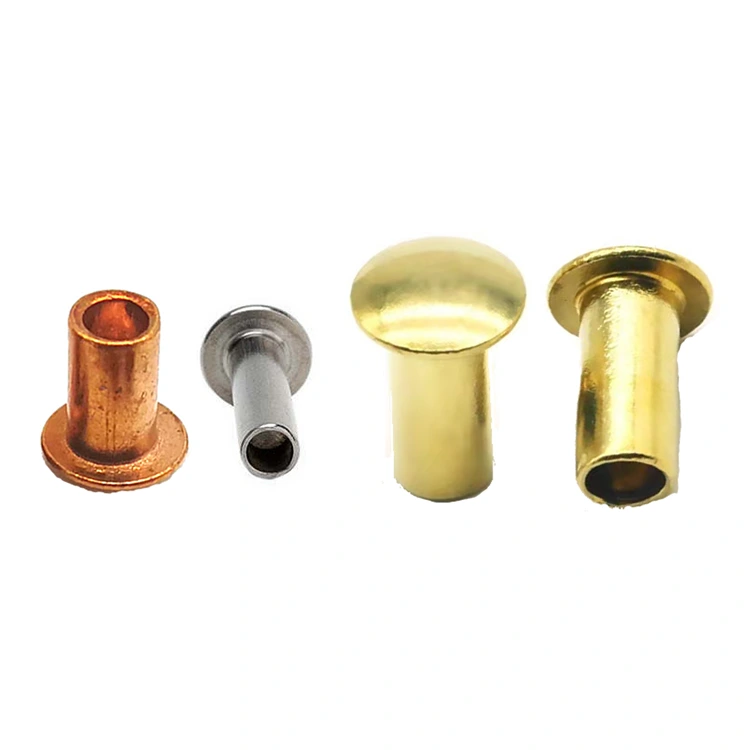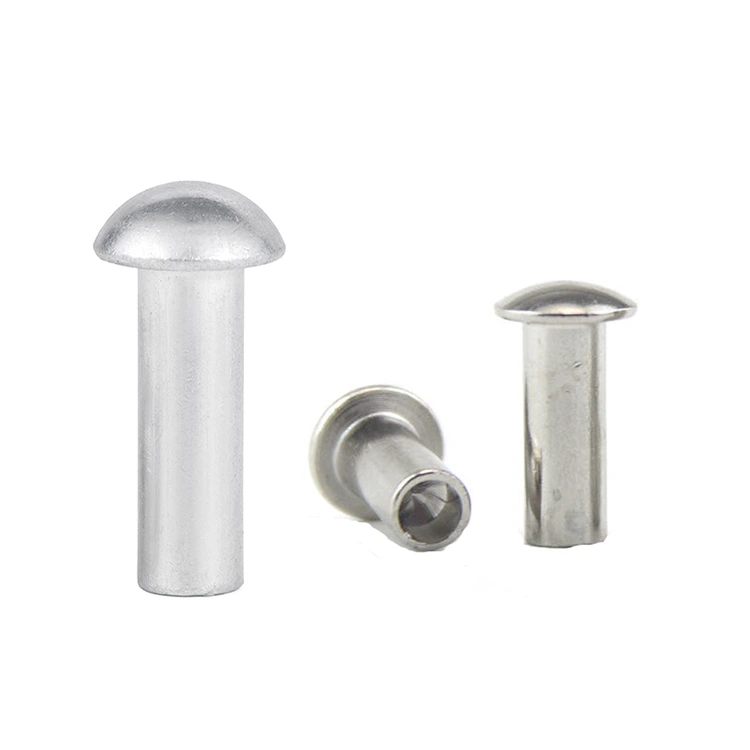Remaches
As one of professional manufacturer in China, Notin would like to provide you Rivets. And we will offer you the best after-sale service and timely delivery.
What is a rivet?
A rivet is a permanent mechanical fastener used to join two or more materials. Rivets work by inserting a metal pin into an aligned hole and deforming the end, creating a strong, secure, and durable connection. Unlike temporary fasteners like screws, rivets do not rely on threads, but instead form a permanent connection, making them ideal for applications requiring high strength, durability, and vibration resistance.
Classification of Rivets
Rivets are typically categorized by head shape, degree of hollowness, or material.
Based on head shape, rivets can be classified as flat head rivets, round head rivets, countersunk head rivets, mushroom head rivets, universal head rivets, truss head rivets, etc.

Based on degree of hollowness, rivets can be classified as solid rivets, semi-tubular rivets, or full tubular rivets.
Based on material, rivets can be classified as brass rivets, stainless steel rivets, steel rivets, aluminum rivets, copper rivets, etc.

What surface finishes are available for rivets?
Rivet surfaces are typically treated with rust-proofing treatments, primarily electroplating, including zinc plating, nickel plating, chrome plating, tin plating, gold plating, and silver plating. Electroplating is a common rust-proofing method for rivets. It applies a layer of plating to the rivet surface through physical or chemical methods. The plating effectively prevents corrosion and rust, while also providing a certain aesthetic effect.
Another special surface treatment method is head coating. Head coating is performed after the rivet is electroplated. This allows for a variety of colors on the rivet head, achieving an aesthetically pleasing finish.
Aluminum rivets cannot be electroplated, but they can be anodized. Anodizing also allows for a variety of color options, but the unit price is higher than electroplating.
Rust-proofing the rivet surface is crucial, effectively extending the rivet's service life and ensuring a secure connection. Different rust-proofing methods are suitable for different environments and applications, so the choice should be tailored to the specific situation.
- View as
Remaches huecos de aluminio
El remache hueco de aluminio es un sujetador común y se usa ampliamente en muchos campos debido a su peso liviano, resistencia a la corrosión y buena conductividad eléctrica. Nuote Metals produce y vende remaches huecos de aluminio en China, tenemos más de 10 años de experiencia laboral en esta industria.
Leer másEnviar ConsultaRemaches semi huecos de latón
En Nuote Metals, nos enfocamos en fabricar remaches semihuecos de latón. Nuestros remaches utilizan principalmente latón H65, una mezcla de cobre y zinc que ofrece una excelente conductividad eléctrica y térmica, además de una sólida resistencia a la corrosión. Este material es lo suficientemente duro y flexible para funcionar bien con procesos de remachado y remachado en frío. Además, el latón tiene ese color dorado natural, por lo que si los usa con fines decorativos, a menudo no necesitará ningún revestimiento adicional.
Leer másEnviar ConsultaRemaches semihuecos de cabeza plana
¿Alguna vez te has preguntado cómo se fabrican nuestros remaches semihuecos de cabeza plana? Aquí hay un recorrido rápido:
Primero, seleccionamos el alambre de metal correcto y lo cortamos a la longitud exacta necesaria. Luego, pasa a la máquina de estampación en frío, que perfora y le da al alambre la forma básica de remache; ahí es donde realmente toman forma la cabeza plana y el vástago hueco. El siguiente paso es el tratamiento térmico; Ajustamos el tiempo y la temperatura según el material para asegurarnos de que cada remache tenga la resistencia y dureza adecuadas. Después de eso, a menudo agregamos un acabado protector (piense en galvanizado o pasivación) para ayudarlos a combatir el óxido y durar más. Y nunca nos saltamos la verificación final: cada lote se revisa para confirmar que el tamaño, el acabado y el rendimiento cumplen con los estándares.
Siempre estamos felices de mostrarles los alrededores a los clientes; si alguna vez estás en el área, ¡avísanos y programaremos un recorrido!
Remaches semihuecos con cabeza de hongo
Los remaches medio huecos con cabeza de hongo reciben su nombre de su distintiva cabeza en forma de cúpula, que se parece un poco a la tapa de un hongo, combinada con un vástago parcialmente hueco. Este diseño permite que el remache se moldee durante la instalación, creando una sujeción fuerte, perfecto para usos en los que se necesita una buena apariencia y un rendimiento sólido. Cuando se coloca, el extremo hueco se ensancha y se agarra firmemente, mientras que la cabeza y la sección superior del vástago permanecen sólidas para brindar soporte adicional.
Leer másEnviar ConsultaRemaches semitubulares de hierro
Los remaches semitubulares de hierro son conectores mecánicos con una cola hueca. Funcionan apretando la parte hueca y ensanchándola hacia afuera para crear una fijación permanente a presión. Las aplicaciones principales se concentran en industrias ligeras como prendas de vestir, calzado y equipaje. El uso de material de alambre blando evita el agrietamiento durante las uniones de remaches y ofrece ventajas de costos. Nuote Metals es un fabricante profesional de remaches semitubulares de hierro. Nuestros remaches son de alta calidad y cada uno se somete a una inspección minuciosa para garantizar la satisfacción del cliente.
Leer másEnviar ConsultaRemaches semi huecos de cabeza avellanada
¿Por qué elegir remaches semihuecos con cabeza avellanada en lugar de otros métodos de conexión? Esto se debe principalmente a sus ventajas únicas. Después de la instalación, el cabezal queda al ras de la superficie, evitando posibles interferencias o riesgos de seguridad causados por protuberancias. El diseño semihueco hace que el proceso de remachado sea relativamente simple y no requiere equipos complejos; Por lo general, se puede completar manualmente o con herramientas neumáticas. Este tipo de remache es adecuado para materiales de distintos espesores y se puede adaptar a diversas situaciones ajustando la fuerza de remachado.
Leer másEnviar ConsultaWhat are the advantages of rivets over other fasteners?
1. Ease of Installation
Rivets are fast to install, and even fully automated for high-volume applications, resulting in a simple and efficient operation process.
2. Connection Reliability
The riveting process is standardized, with strict quality control, resulting in highly stable connections. Visual inspection allows for quick verification of connection quality.
3. Vibration and Impact Resistance
Rivets connect through deformation or interference fit, providing strong clamping force and excellent vibration resistance, capable of withstanding vibration and shock.
4. Low Cost
Rivets are easy to install and can be fully automated, saving significant labor costs.
What are the advantages and disadvantages of rivets made of different materials?
Aluminum Rivets
Advantages: Lightweight, reduces overall product weight, low cost, suitable for general civilian applications.
Disadvantages: Low tensile and shear strength, unsuitable for high-strength workpieces, prone to electrochemical corrosion when in contact with metals such as stainless steel.
Stainless Steel Rivets
Advantages: Strong corrosion resistance, high hardness, suitable for high-strength workpieces (such as marine equipment)
Disadvantages: Higher cost, typically more expensive than aluminum rivets of the same specification.
Brass and Copper Rivets
Advantages: Excellent conductivity (such as connecting electronic components), good corrosion resistance.
Disadvantages: Higher cost, more difficult to process.
Steel Rivets
Advantages: High hardness, high connection reliability, and wide applicability.
Disadvantages: Compared to other materials, iron rivets are more prone to rusting.
What are the main applications of rivets?
Rivets have a wide range of uses, from small items like a pair of scissors to large items like airplanes and ships, as well as in high-precision medical applications.
Industrial Manufacturing
Rivets are used in a wide variety of industrial fields, wherever there is a need to connect two or more materials.
Electronics
Rivets secure heat sinks and chips, providing both vibration damping and noise reduction, and are widely used in the cooling systems of electronic products such as computers and mobile phones.
Automotive
Rivets are widely used to connect components of automobile bodies and chassis, such as doors and hoods. Their lightweight and corrosion-resistant properties make them an indispensable joining method in automotive manufacturing.
Aerospace
In aircraft manufacturing, rivets are used to connect different fuselage components, such as wings and tailplanes. Millions of rivets create high-strength, corrosion-resistant joints. Aluminum and titanium alloy rivets are often used to connect components of corresponding materials, ensuring stability in extreme environments.
Rivets are used everywhere. The above examples only represent a small number of their applications. We see rivets everywhere in our daily lives, such as on scissors, folding beds, and strollers etc. Rivets can be customized to different sizes and materials depending on the application.
Nuote Metals has specialized in the rivet industry for over a decade. Our factory is located in Dongguan, a city known as the "World Factory," a city with a developed industry and convenient transportation. This allows us to respond quickly when acquiring raw materials and supporting surface treatments, meeting our customers' needs for quick access to samples and bulk orders. We produce 10 million rivets daily and have molds of various specifications, allowing us to produce rivets as small as 0.8mm and as large as 10mm. We welcome your inquiries and visits.

